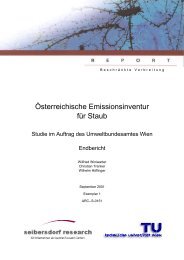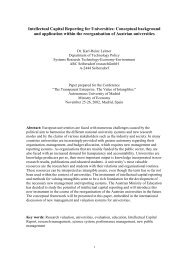ALPMON FINAL REPORT - ARC systems research
ALPMON FINAL REPORT - ARC systems research
ALPMON FINAL REPORT - ARC systems research
Create successful ePaper yourself
Turn your PDF publications into a flip-book with our unique Google optimized e-Paper software.
Contract ENV4-CT96-0359 <strong>ALPMON</strong><br />
countries. The methodology was developed by the „Joint Research Centre“ (JRC) in Ispra, Italy (EUR<br />
1993).<br />
The methodology is based on visual interpretation of satellite data including the use of ancillary data<br />
(topographical and thematic maps, statistics etc.). The photo-interpretation was performed on the basis<br />
of colour hardcopies of geocoded multi-spectral satellite data in a scale of 1 : 100.000. The different<br />
cover types were mapped according to the CORINE land cover Nomenclature, which consists of 44<br />
different land cover / land use types (Table 10). The surface area of the smallest unit mapped is 25<br />
hectares. For linear elements the minimum width is 100 meters. Finally, the interpretation results were<br />
scanned and integrated into a geographical information system. The digital CORINE land cover data<br />
are stored according to the official topographical map projection system of the single member states.<br />
2.3.6.2 User Requirements<br />
The interest of the NRCs, represented by the Austrian Environment Agency, concentrates on the<br />
possibilities to reduce the effort of visual interpretation and thus the costs of up-dating the CORINE<br />
land cover maps. This could be achieved by applying an automated approach as performed in the<br />
<strong>ALPMON</strong> project as alternative to photo-interpretation. However, it has to be noticed that formalised<br />
methods of pattern recognition cannot currently replace the ability of a human vision system. On the<br />
other hand they provide reproducible results that are more consistent than the results of visual<br />
interpretation. In addition it might be possible to extract more detailed information to be added as level<br />
4 classes to the CORINE nomenclature. Objective of this work package is thus an evaluation of the<br />
results of the automatic classification performed in <strong>ALPMON</strong> compared to the original CORINE<br />
interpretation including the introduction of additional level 4 classes.<br />
2.3.6.3 Applied Methods<br />
Compared to the CORINE land cover maps the <strong>ALPMON</strong> data base has been derived from semiautomatic<br />
classification of digital satellite imagery. According to the processing chain developed in the<br />
course of the <strong>ALPMON</strong> project the following procedures have been applied:<br />
� Geocoding<br />
� Topographic normalisation<br />
� Atmospheric correction<br />
� Image fusion (optional)<br />
� Numerical classification<br />
The resulting thematic maps refer to the nomenclature defined in the <strong>ALPMON</strong> project (Table 11).<br />
Minimum mapping unit is the single pixel.<br />
JR, RSDE, ALU, LMU, Seibersdorf, WSL 58




